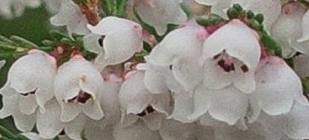Erica quadrangularis
Erica quadrangularis Salisb.
Family: Ericaceae
Common names: baby heath, square heath
Introduction
Erica quadrangularis is an easy-to-grow, graceful shrub, which turns white or pink during late winter, spring to early summer.when it gets covered in masses of small flowers.

Description
Description
Erica quadrangularis forms an upright shrub up to 600 mm, with branches mostly extending outwards nearly horizontally. During its flowering season from mid-winter until early summer (July to November), the whole bush is covered with masses of small (2-3 mm long) cup-shaped flowers. Plants have either white flowers or white tinged with pink or are a shade of pink, from pale to rosy pink.

Conservation Status
Status
Least Concern. Erica quadrangularis is not threatened (Raimondo et al. 2009).
Erica quadrangularis has escaped cultivation and naturalised in parts of southern Victoria and south-eastern South Australia, and is regarded as an environmental weed in Victoria, and a potential environmental weed in other parts of southern Australia. It was first recorded as naturalised in Victoria in 1988. In Australia it is known as Angled Heath.
Distribution and habitat
Distribution description
Erica quadrangularis grows in seepage areas on sandy flats, on lower mountain slopes and on moist clay banks. It sometimes forms dense colonies. It occurs from Clanwilliam through the Boland to Knysna and inland as far as the Swartberg and Kammanassie mountain ranges.
Derivation of name and historical aspects
History
The genus Erica gets its name from ereiko, to break, either because of the ability of the plant to break up bladder stones or, more probably, because the stems are brittle and break easily. This species is named for its square corolla, quadrangularis meaning four-angled in Latin.

Ecology
Ecology
Erica quadrangularis is pollinated by insects. The seeds fall out of the flowers when ripe, and are scattered around the parent plant.

Uses
Use
Erica quadrangularis makes a decorative garden shrub and pot plant, and is well known to many gardeners and is widely available in retail nurseries both at home and in other parts of the world. It is also a long-lasting cutflower. In other parts of the world it is known as Easter Heather or Spring Heather.
Growing Erica quadrangularis
Grow
Grow Erica quadrangularis in well-drained acidic (pH between 5 and 6.5) soil, in a sunny or semi-shaded position. It prefers a moderate to well-watered site, but it must have good drainage. It will take sandy soils and heavier clay soils. Feed in autumn and spring with a generous mulch of well rotted compost and low doses of fertilizer (no manure). Prune lightly to shape. Grow it in the fynbos garden, in the rockery, on terraces, in the mixed shrubbery, mixed borders This heath is also suitable for containers, using a well-drained, acidic, sandy loam, containing 50% well rotted compost, but no manure or strong fertilizers (use slow release or low doses).

Propagate by seed or cuttings. Sow seed in late summer to autumn (March-May), in well-drained sandy soil. Keep warm and moist. Treatment with Instant Smoke Plus Seed Primer will enhance germination. Use a well-drained, acidic medium. Because the seed is so fine it needs only a light covering of clean sand, or the seeds can be mixed with dry sand and the mixture of seed and sand spread in a thin layer on top of the sowing medium. Water with a fine rose to avoid displacing the seeds. Keep the trays damp but not wet and out of direct sun in a warm, but not hot, situation. Germination takes 1 to 2 months. Transplant the seedlings when they are about 10 mm high. Grow on in light shade until they are established.
Take semi-hardwood heel cuttings in late summer, autumn or spring. Treat with a rooting hormone suitable for semi-hardwood cuttings. Place in well-aerated medium, under mist on heated benches (24 o C). Pot the rooted cuttings in a well-drained, acidic soil medium and harden off in light shade for a month or two.
References
- Goldblatt, P. & Manning, J. 2000. Cape plants. A conspectus of the Cape Flora of South Africa. Strelitzia 9. National Botanical Institute, Pretoria & Missouri Botanical Garden Press, Missouri.
- Plants of southern Africa: an online checklist. http://posa.sanbi.org
- Raimondo, D., Von Staden, L., Victor, J.E., Helme, N.A., Turner, R.C., Kamundi, D.A. & Manyama, P.A. (eds) 2009. Red List of South African plants 2009. Strelitzia 25. South African National Biodiversity Institute, Pretoria.
- Schumann, D., Kirsten, G. & Oliver, E.G.H. 1992. Ericas of South Africa . Fernwood Press, Cape Town
- Weeds of Australia Biosecurity Queensland Edition, http://keyserver.lucidcentral.org/weeds/data/03030800-0b07-490a-8d04-0605030c0f01/media/Html/Erica_quadrangularis.htm. Accessed 25 January 2013
Credits
Alice Notten
Kirstenbosch National Botanical Garden
February 2013
Plant Attributes:
Plant Type: Shrub
SA Distribution: Western Cape
Soil type: Sandy, Clay, Loam
Flowering season: Spring, Early Summer, Winter
PH: Acid
Flower colour: White, Pink
Aspect: Full Sun
Gardening skill: Average
Special Features:
Horticultural zones









Rate this article
Article well written and informative
Rate this plant
Is this an interesting plant?
Login to add your Comment
Back to topNot registered yet? Click here to register.